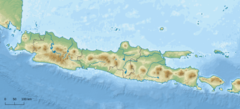This article needs additional citations for verification. (August 2021) |
| Elephas hysudrindicus Temporal range: Pleistocene
| |
|---|---|

| |
| Elephas hysudrindicus in the Bandung Geological Museum | |
| Scientific classification | |
| Domain: | Eukaryota |
| Kingdom: | Animalia |
| Phylum: | Chordata |
| Class: | Mammalia |
| Order: | Proboscidea |
| Family: | Elephantidae |
| Genus: | Elephas |
| Species: | †E. hysudrindicus
|
| Binomial name | |
| †Elephas hysudrindicus Dubois, 1908
| |
| Sunggun Archaeological Site in Blora, Java | |
Elephas hysudrindicus, commonly known also as the Blora elephant in Indonesia (lit. Gajah Blora in Indonesian), is a species of extinct elephant from the Pleistocene of Java. It is anatomically distinct from the Asian elephant, the last remaining species of elephant under the genus Elephas.[1][2] The species existed from around the end of the Early Pleistocene until the end of the Middle Pleistocene, when it was replaced by the modern Asian elephant, coexisting alongside fellow proboscidean Stegodon trigonocephalus, as well archaic humans belonging to the species Homo erectus.[3][4]
- ^ Hooijer, D. A. (1955). Fossil Proboscidea from the Malay Archipelago and the Punjab. Zoologische Verhandelingen, 28 (1): 1–146.
- ^ Cite error: The named reference
:1was invoked but never defined (see the help page). - ^ Puspaningrum, Mika R.; van den Bergh, Gerrit D.; Chivas, Allan R.; Setiabudi, Erick; Kurniawan, Iwan (January 2020). "Isotopic reconstruction of Proboscidean habitats and diets on Java since the Early Pleistocene: Implications for adaptation and extinction". Quaternary Science Reviews. 228: 106007. Bibcode:2020QSRv..22806007P. doi:10.1016/j.quascirev.2019.106007. S2CID 212876762.
- ^ Rizal, Yan; Westaway, Kira E.; Zaim, Yahdi; van den Bergh, Gerrit D.; Bettis, E. Arthur; Morwood, Michael J.; Huffman, O. Frank; Grün, Rainer; Joannes-Boyau, Renaud; Bailey, Richard M.; Sidarto; Westaway, Michael C.; Kurniawan, Iwan; Moore, Mark W.; Storey, Michael (2020-01-16). "Last appearance of Homo erectus at Ngandong, Java, 117,000–108,000 years ago". Nature. 577 (7790): 381–385. doi:10.1038/s41586-019-1863-2. ISSN 0028-0836. PMID 31853068. S2CID 256822928.
